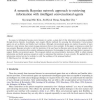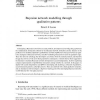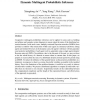IJAR
2000
14 years 2 months ago
2000
Multiply sectioned Bayesian networks (MSBNs) provide a coherent and flexible formalism for representing uncertain knowledge in large domains. Global consistency among subnets in a...
AI
2002
Springer
14 years 2 months ago
2002
Springer
This paper provides algorithms that use an information-theoretic analysis to learn Bayesian network structures from data. Based on our three-phase learning framework, we develop e...
IPM
2007
14 years 2 months ago
2007
As access to information becomes more intensive in society, a great deal of that information is becoming available through diverse channels. Accordingly, users require effective ...
AI
2005
Springer
14 years 2 months ago
2005
Springer
In designing a Bayesian network for an actual problem, developers need to bridge the gap between ematical abstractions offered by the Bayesian-network formalism and the features o...
ML
2006
ACM
14 years 2 months ago
2006
ACM
We present a new algorithm for Bayesian network structure learning, called Max-Min Hill-Climbing (MMHC). The algorithm combines ideas from local learning, constraint-based, and sea...
DKE
2007
14 years 2 months ago
2007
One of the main factors for the knowledge discovery success is related to the comprehensibility of the patterns discovered by applying data mining techniques. Amongst which we can...
IJBIDM
2006
14 years 2 months ago
2006
: Appraisal of companies is an important business activity. We mainly apply Bayesian networks for this classification task for Japanese electric company data. Firstly, few standard...
IJAR
2008
14 years 2 months ago
2008
Cooperative multiagent probabilistic inference can be applied in areas such as building surveillance and complex system diagnosis to reason about the states of the distributed unc...
BMCBI
2006
14 years 2 months ago
2006
Background: A central goal of molecular biology is to understand the regulatory mechanisms of gene transcription and protein synthesis. Because of their solid basis in statistics,...
ASC
2006
14 years 2 months ago
2006
For some time, learning Bayesian networks has been both feasible and useful in many problems domains. Recently research has been done on learning equivalence classes of Bayesian n...



